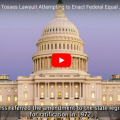Anyone who thinks states should consider ratifying the proposed Federal Equal Rights Amendment should look at what just happened in New Mexico.
A judge there took their state’s equal right amendment, worded almost identically to the proposed federal amendment, and used it to allow same-sex marriage in that state.
Six county clerks in New Mexico have started issuing same-sex marriage licenses. New Mexico District Judge Alan Malott recently ruled that same-sex marriage was protected by the New Mexico State Constitution. He partially relied on a 1972 statewide vote to place a state version of the proposed federal Equal Rights Amendment in the New Mexico Constitution.
Back then, the issue was framed as a vote to protect women in the workplace—equal pay for equal work. Few could have imagined that 40 years later that same law would be used by a judge to legalize same-sex marriage.
Most people don’t know it, but the federal Equal Rights Amendment is still in play nationally. In 1972, congress referred the amendment to the states for ratification. Under the U.S. Constitution, 38 states must approve an amendment in order for it to become part of the U.S. Constitution. To date, 35 states have ratified the federal Equal Rights Amendment. Congress imposed a deadline of June 30, 1982 for ratification by the states.
ERA proponents believe deadlines for ratification are unconstitutional and that ERA and all other amendments not yet ratified are still in play.
That’s why our own Sen. Joyce Elliott, (D-Little Rock) and others routinely try to get the Arkansas Legislature to ratify the amendment. They believe ratification by just 3 more states will put the Equal Rights Amendment in the U.S. Constitution.
Imagine how much more damage the U.S. Supreme Court could have done last June if they had been able to leverage an Equal Rights Amendment against marriage.
Here is a link to an article in the Albuquerque Journal for more information.



